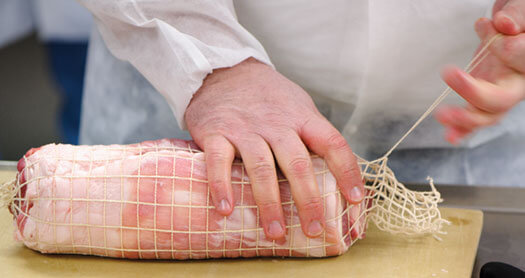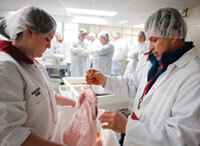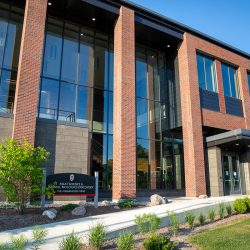Six Degrees of [Curing] Bacon

A pork belly is tied in a roll during a demonstration of how smoke flavoring can replicate the dry-curing process to make bacon. Photo: Jeff Miller.
This new program teaches the art and science of working with meat.
Craig Huth grew up working in the family meat-processing business, Richland Locker. But as he made plans to take over when his parents retire, he knew he still had a few skills to learn — including the art of making sausage.
This is Wisconsin, after all.
“If the sausage man goes on vacation for a week, I’m the one who’s going to do it,” says Huth, who worked for General Motors for ten years before returning home to Richland Center, Wisconsin, where his great uncle started the meat-processing company in 1939.
Huth was just the type of student UW–Madison meat scientists had in mind last year when they launched a meat-science-and-safety training program designed to help a new generation of leaders earn the title “master meat crafter.”
The concept comes from Germany, where they know a thing or two about sausage. A German wurstmacher is required to undergo intense training and an apprenticeship before being permitted to own a shop. In Wisconsin, the inaugural class of nineteen students travels to the UW about six times in two years for two- to three-day training sessions that combine classroom instruction with hands-on activities in the laboratory and demonstrations of new technology.
That brings us to meat-curing school. More important: bacon.
Students in long white coats and hairnets gather around as Jeff Sindelar, a UW meat scientist in the College of Agricultural and Life Sciences and the program’s director, demonstrates how to turn the fresh pork bellies stacked nearby in white plastic bins into bacon with different flavor profiles. The laboratory feel is fitting, as it turns out there’s some science involved.
Sindelar gets an assist from Doug Ney ’95, a self-described “meathead” who works for Red Arrow USA, a company that makes several varieties of smoke flavoring, also called “liquid smoke,” such as apple, hickory, maple, and mesquite. The class observes how to add flavor using an injector machine, a method that replicates the results of older and much slower practices of dry curing. The pork belly moves along a conveyor belt beneath a row of pumping needles connected to hoses that deliver water and a foamy mixture containing the liquid smoke. While the smoky smell is almost overpowering, there’s no smoke anywhere.

Bacon before long: Doug Ney (right), with help from Amanda King, a research assistant, shows how his company dredges pork bellies to create different flavor profiles. Photo: Jeff Miller.
Sindelar admits that there is a bit of trial and error involved in determining how much liquid to inject. “You’re always working on averages,” he says. The students will get to taste for themselves how it turns out at a meal capping off the two-day meat-curing lessons.
The meat-processing industry is big business in Wisconsin, contributing more than $12 billion a year to the economy. That’s one reason the state Department of Agriculture, Trade, and Consumer Protection provided grant money to support the program, which aims to help business owners such as Huth to understand the art and science of meat processing, develop new products, find new markets, and master food safety.
“These folks are taxed with a workload — not only from just making good products and finding a customer base to sell those products to — but they also have a lot of regulation they have to comply [with], and that’s a big challenge,” Sindelar says. “It’s extremely complex.”
The students, who pay $3,000 for tuition, are a mix of industry veterans — including the president of the Wisconsin Association of Meat Processors — and those newer to the business. Some, including Huth, have bachelor’s degrees, but many don’t.
“Everyone is overwhelmed at some point in time,” Sindelar says. “That’s okay. We want that to happen, because if they’re overwhelmed, that means that they’re challenged.”
In addition to homework assignments and quizzes, the students must conduct a research project based in their own meat plants and take on an apprentice to share what they have learned, helping the students retain their own skills in the process of teaching.
“If they teach other people what they know, there’s a much higher likelihood that those people are going to stay in the meat industry … maybe open their own businesses — and hopefully, increase the Wisconsin meat industry in the future,” Sindelar says.
Wisconsin’s meat-processing industry boasts some big names: Oscar Mayer, for one. But a large majority of the state’s 450 meat plants are small, family operations such as Richland Locker, which does everything from slaughtering and butchering cows, deer, pigs, and sheep, to making sausage and bacon.
“You name it, we make it,” Huth says. On one visit, about ten employees work steadily at massive, stainless steel tables to break down a side of beef, then cut and package it, something they do two dozen times a week. In the next room, the sausage man uses a small machine to fill casings with meat.
Huth hopes putting a “master meat crafter” sticker on his products will be a good marketing tool, especially to reach customers who visit the area for deer-hunting season. “Hopefully, it’s a good draw to bring them here, because Richland Center’s not a big destination on the map,” he says.
So far, Huth has valued the chance to network with others who are taking over a family business. And he’s learned key lessons about food safety and complex federal regulations, at times helping him stay as current as the inspectors who visit his plant.
“I see [these students] as the next generation,” Sindelar says. “They have the hands-on training from just working every day in the business, but they’re getting the scientific training to make them successful to keep that business going.”
Jenny Price ’96 is senior writer for On Wisconsin Magazine.
Published in the Fall 2011 issue



Comments
Marion Greaser September 20, 2011
The information presented in the “UW Bragging Rights” section on P 43 for the Fall On Wisconsin magazine is partially factually incorrect. Dr. Briskey coined the term “pale, soft, and exudative” (PSE) to described pork that was poor quality. He did not devise any practical method for transforming it into a qualty product. The term “the other white meat” is a slogan developed by the National Pork Board to advertise high qualty pork as a competitor for chicken and fish. Dr. Briskey can be called “The Father of Pork Quality” and he did play a major role in bringing biochemistry to the study of meat science.